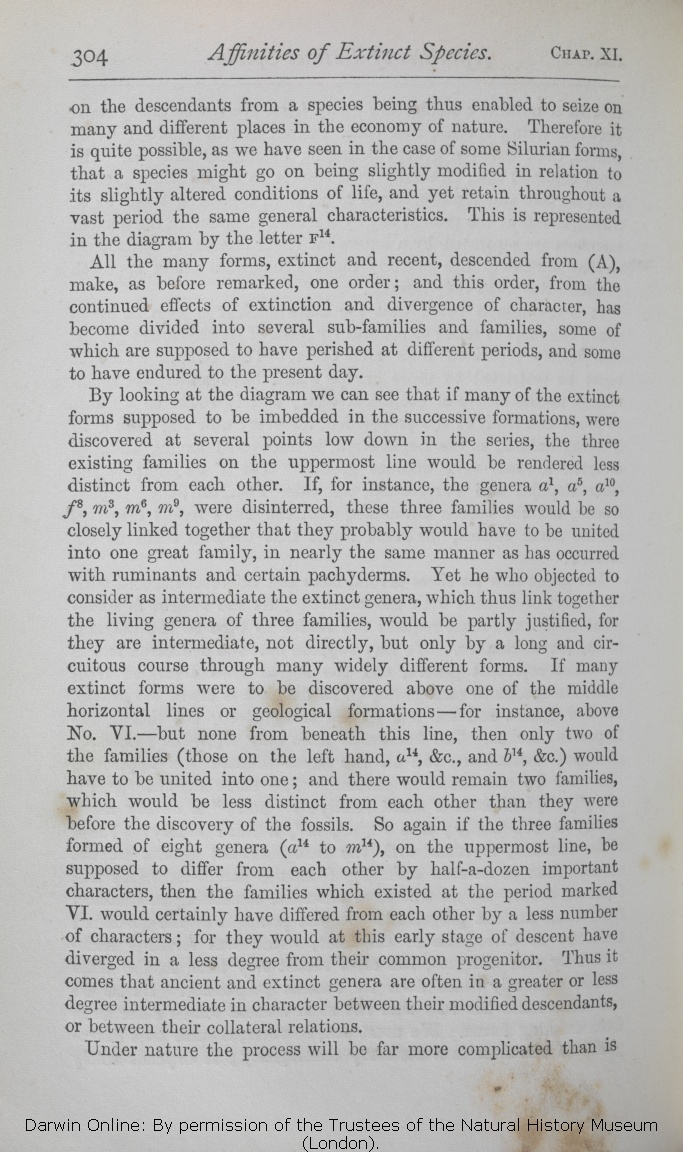All the many forms, extinct and recent, descended from
(A), | (A), 1860 1861 1866 1869 1872 | | A, 1859 |
|
By looking at the diagram we can see that if many of the extinct
forms | forms 1872 | | forms, 1859 1860 1861 1866 1869 |
| imbedded 1872 | | embedded 1859 1860 1861 1866 1869 |
|
a
10
,
1872 |
|
a
10
,
1859 1860 1861 1866 1869 |
|
m
6
,
1872 |
|
m
6
,
1859 1860 1861 1866 1869 |
| disinterred, 1859 1860 1861 1869 1872 | | distinterred, 1866 |
| certain pachyderms. 1861 1866 1869 1872 | | pachyderms. 1859 1860 |
| consider as intermediate 1872 |
| call 1859 1860 1861 1866 1869 |
| genera, 1859 1860 1861 1872 | | genera 1866 1869 |
| link together 1872 | | linked 1859 1860 1861 1866 1869 |
| families, 1872 | | families 1859 1860 1861 1866 1869 |
| OMIT 1872 |
| together, intermediate in character, 1859 1860 1861 1866 1869 |
| partly justified, for 1872 |
| justified, as 1859 1860 1861 1866 1869 |
| this 1859 1860 1861 1869 1872 | | his 1866 |
| ..... 1866 1869 1872 | | the 1859 1860 1861 |
| of the families (those 1866 1869 1872 |
| families 1859 1860 1861 |
| hand, 1866 1869 1872 | | hand 1859 1860 1861 |
| ..... 1866 1869 1872 | | (namely, 1859 1860 1861 |
|
a
14
,
1859 1860 1861 1866 1872 |
|
a
14
,
1869 |
|
b
14
,
1859 1860 1861 1866 1872 |
|
b
14
,
1869 |
| one; 1866 1869 1872 | | one 1859 1860 1861 |
| ..... 1866 1869 1872 | | family; 1859 1860 1861 |
| there would remain two families, which would be less distinct from each other than they were before the discovery of the fossils. 1866 1869 1872 |
|
the two other families (namely,
a
14
to
f
14
now including five genera, and
o
14
to
m
14
) would yet remain distinct.
1859 1860 1861 |
|
m
14
),
1872 |
|
m
14
),
1869 |
| half-a-dozen 1872 |
| half a dozen 1869 |
| 1 blocks not present in 1866 1869 1872; present in 1859 1860 1861 | | These two families, however, would be less distinct from each other than they were before the discovery of the fossils.
|
| a greater or less 1872 |
| some slight 1859 1860 1861 1866 1869 |
| character 1859 1860 1861 1869 1872 | | cha- racter 1866 |
|









